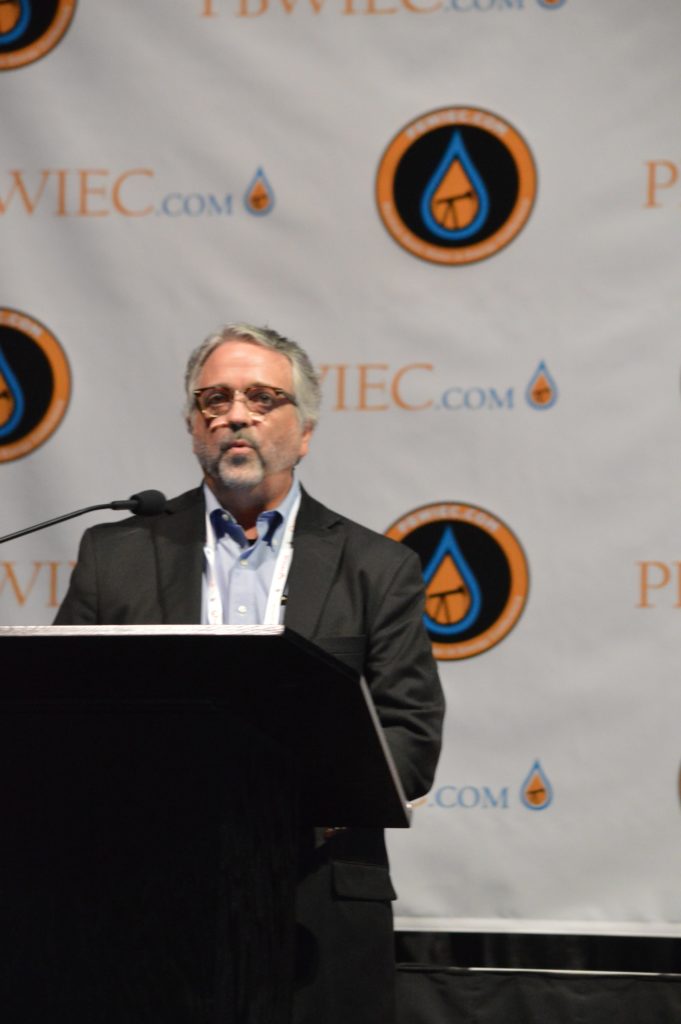Last month’s issue was called our “Water Issue” (see photo), so we can’t slap that label on this issue, or this coverage, anyway. We’ll just call this “Overflow.” It’s some additional insights we weren’t able to squeeze into the April issue.
By Jesse Mullins
Some isolated, maybe random, observations about H2O and the tidal wave it has created in the Basin…
Best Quote
The best quote heard during the Permian Basin Water in Energy Conference (PBWIEC), held in March in Midland:
“The Permian is one of the world’s greatest assets, and solving the water problems here is well worth doing.” —Scott Mitchell, Co-CEO Waterfield Midstream
From the Other Side
It came as something of a surprise to some attendees, or at least to this attendee, to see the name of Dan Mueller, director of the Environmental Defense Fund, on the speaker slate for the second day of PBWIEC, but Mueller surprised further by giving a talk that gave perspective to the issues at hand and came across as fair-handed as well.
Mueller informed the attendees that EDF appreciates the opportunity to talk about what it is doing and to give its perspective. “But more importantly, we attend these workshops and conferences to learn from the folks like yourselves who actually out there DOING this stuff,” Mueller said. “That is is so very critical in our work, for us to be able to come up with a reasonable stance on what the issues and questions might be, and on what needs to be addressed.”
He proceeded to define the issue at hand, as it is presently understood, not just by EDF but presumably by the oil and gas industry itself.
“The Permian Basin is producing a lot of water and is going to be producing a lot MORE water,” he said. “The Permian Basin is the hotbed of this issue. It’s in the news A LOT.”
He gave a nod to some cases where water was being handled efficiently and resourcefully, but he came back with the obvious: “On balance, there is going to be excess water to be dealt with. Even if you are recycling the most that you can. Right now most of this water is going into disposal wells. But there is talk and there is some action going on, about doing something else with this produced water. Irrigation is one such [prospect].”
Mueller didn’t dwell on the virtues of one proposed solution versus another proposed solution. He went, instead, into the thornier question of just what produced water is, and how the business of “treating” produced water is a complex question that must take into account the re-use itself.
“So we’re looking at the question of re-use and recycling of water, and of whether you use it BACK in the completion operations or use it for something else. There are varied levels of environmental risks with that.
“If you use it back for completion purposes, you might do some treatment, [but] you certainly are going to store it and transport it more than you would if you were just going to put it down a disposal well,” Mueller continued. “So one of the issues is leaks and spills. Now, if you do something ELSE with that produced water, you’re still going to have to do something more robust with it, whether it involves moving this fluid around or storing it more, but also you’re going to be intentionally releasing it into the environment [for some other purpose].
And it is there, Mueller said, that the questions become more involved.
He remarked that one sometimes sees, at oil and gas events, someone making a presentation and, as part of their talk, holding up a beaker of very cloudy water and another of crystal clear water. “And they’ll say, ‘We’ve got this treatment’ [to turn the water crystal clear]… and ‘Isn’t that great?’ Well, YES, it is. You took a LOT of stuff out of that water. And you made it clear. But that doesn’t mean you made it clean. There is still stuff in there that could be of concern. Particularly with regard to how you intend to use it later. So it’s all about the analytics of [the water treatment], not about what it looks like.”
He added: “Produced water is an industrial effluent water. Once it’s treated, it has gone through a process. It has had chemicals added. It has chemicals IN it. It has to be treated. Just because it’s clear doesn’t mean it is clean.”
High Swells
During a panel on Gathering and Disposal, Nick Hines, EVP/Permian for Oilfield Water Logistics, concluded what was one of the better panels of the day with this remark:
“We have several growth projects, like my peers [on the panel onstage], and in the Lea County area we are expanding out with large pipeline networks, and continuing to grow,” Hines said. “As we all know, there is a wall of water coming. We are experiencing it today. Most of the operators out here know that the water production , especially in the Delaware [Basin] is increasing dramatically, and those are things we are focusing on. We are trying to be operator-focused, to gather that water, dispose of it responsibly, and do it cost effectively, so we can pass those cost savings on to our operators.”
M&A Matters
One of Hines’ co-presenters on that panel was Tommy Thompson, vice president of engineering for Goodnight Midstream. Thompson’s company was acquired only days later by TPG Capital. The acquirer obtained a majority stake in Goodnight for $930 million. The prospect of merger and acquisition activity in water midstream was a prospect that came up for conversation during PBWIEC. Some industry observers feel that the water midstream field, which now has numerous players in it, many of whom are aggressively building their assets, is a field that is ripe for M&A deals.
Last month in this magazine there was discussion of another M&A deal, that of Louisiana-based Tetra Technologies acquiring Swiftwater Energy Services, as it did in 2018. We spoke with Swiftwater founder Hunter Morris—now vice president of the central United States for Tetra—about the rationale behind that deal.
Morris said that there were a number of factors.
“First and foremost, Swiftwater had a leading position, in my view, in the water management space in the Permian Basin, and Tetra wanted to increase their position within the Permian Basin,” Morris said. “I think that, culturally speaking, that was really important because we are a service business. We have several hundred employees in the Midland/Permian Basin region. And the strong cultural values that Swiftwater had were very much aligned with Tetra’s leadership culture, and so that was very important that they found the company to acquire where they weren’t just buying an asset, they were buying [its] people.
“And then, in addition to all that, of course they wanted to really increase their position and their footprint in the Permian to take advantage of the growing opportunities out here. But Swiftwater had a dynamic integrated service platform that Tetra did not have. And so, the acquisition of Swiftwater has allowed Tetra to take basically all these different service lines that Swiftwater had. For instance, water treatment and recycling. Tetra really wasn’t doing that beforehand on any scale.
“So there were several different services they got—what we call our “integrated portfolio services,” or our integrated service model,” Morris said. “Tetra wanted to acquire Swiftwater to be able to leverage those services that they did not have before, and also expand those services into other regions throughout North America. That’s one of my initiatives, as a Tetra employee now, in working with the other regions in North America. It’s to expand those Swiftwater services and technologies into the other regions.”
What Morris described is possibly an M&A model that will manifest itself in other water midstream deals yet to come. With such a young and fast-growing niche, the dynamics and economics of putting one company with another company would seem to make much sense. The bigger the network, the more an entity can offer. And the network building has barely begun in water midstream.
Every professional working in the water industry in the Permian Basin is a pioneer. What they do has not been done before. How they proceed, and what they accomplish, will have lasting effects on the productivity of America’s premier energy basin.











